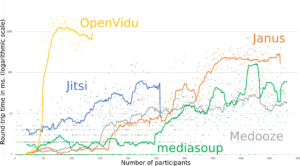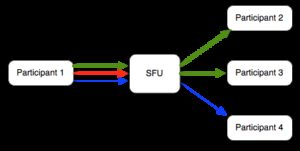Deploying media servers for WebRTC has two major challenges, scaling beyond a single server as well as optimizing the media latency for all users in the conference. While simple sharding approaches like “send all users in conference X to server Y” are easy to scale horizontally, they are far from optimal in terms of the […]
sfu
Breaking Point: WebRTC SFU Load Testing (Alex Gouaillard)
If you plan to have multiple participants in your WebRTC calls then you will probably end up using a Selective Forwarding Unit (SFU). Capacity planning for SFU’s can be difficult – there are estimates to be made for where they should be placed, how much bandwidth they will consume, and what kind of servers you […]
Suspending Simulcast Streams for Savvy Streamlining (Brian Baldino)
If you’re new to WebRTC, Jitsi was the first open source Selective Forwarding Unit (SFU) and continues to be one of the most popular WebRTC platforms. They were in the news last week because their parent group inside Atlassian was sold off to Slack but the team clarified this does not have any impact on the Jitsi […]
Chrome’s WebRTC VP9 SVC Layer Cake: Sergio Garcia Murillo & Gustavo Garcia
Multi-party calling architectures are a common topic here at webrtcHacks, largely because group calling is widely needed but difficult to implement and understand. Most would agree Scalable Video Coding (SVC) is the most advanced, but the most complex multi-party calling architecture. To help explain how it works we have brought in not one, but two WebRTC video architecture experts. […]
Optimizing video quality using Simulcast (Oscar Divorra)
Dealing with multi-party video infrastructure can be pretty daunting. The good news is the technology, products, and standards to enable economical multiparty video in WebRTC has matured quite a bit in the past few years. One of the key underlying technologies enabling some of this change is called simulcast. Simulcast has been an occasional sub-topic […]






